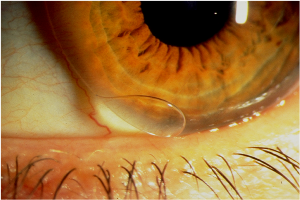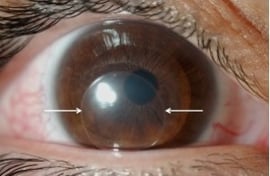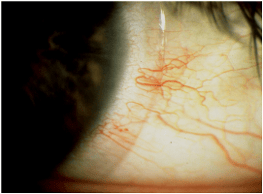As with any custom soft contact lens it is imperative to make sure the fit of the contact lens is correct and optimal before chasing vision. It is only when fit and centration are achieved that a practitioner can move on to mastering the patient’s vision. So, let’s chat about characteristics of a flat and steep custom soft contact lens as well as some tips for correction.
Flat/Loose Custom Soft Contact Lens: Ideally we aim for a contact lens that matches closely to the sagittal depth of the eye, thus producing an optimal cornea to contact lens relationship. Characteristics that reveal a flat fitting custom soft contact lens include, but are not limited to, lens decentration, excessive movement with the blink, dislodgement of the lens during the push-up-test, edge lift or standoff, and bubbles seen in the periphery of the lens. Another possible indicator of a flat custom soft contact lens is unstable lens rotation.

Flat Contact Lens with Poor Centration

Flat Contact Lens with Edge Lift
To correct for a flat fitting custom soft toric, sphere, or multifocal contact lens the practitioner must make a change that will increase the sagittal depth of the lens. There are two possible ways to accomplish an increase in sagittal depth and those are increase in the overall diameter of the contact lens or steepening of the base curve by decreasing the base curve value (i.e. - changing base curve from 8.2mm to 8.0mm). SpecialEyes consultants are trained to assist you in correcting a fit issue with a custom soft contact lens. They are experienced in deciding the best parameter (base curve or diameter) to change as well as how much of change will create the best outcome for your patients. Please feel free to reach out to consultation at seconsult@bvimedical.com or submit your consultation request online.
Steep/Tight Custom Soft Contact Lens: The other scenario we may come across when fitting a custom soft sphere, toric or multifocal contact lens is a steep or tight fitting lens. For a steep fitting lens, slit lamp examination will reveal characteristics such as limited or no lens movement on blink, bubble in the center of the lens, vision clearing immediately after blink and then blurring again, difficulty dislodging lens when performing push-up-test, as well as possible hypoxia or vascularization.

Steep Lens with Apical Bubble

Tight Lens Affecting Conjunctiva
It is in these scenarios where the sagittal depth of the contact lens must be decreased or the lens flattened. Again, the two options we have that will decrease the sagittal depth of the custom soft contact lens are base curve and diameter. Flattening the base curve by increasing the base curve value or decreasing the overall diameter of the contact lens will decrease the sagittal depth and correct for a tight fitting lens.
Rotated Custom Soft Toric Contact Lens: If slit lamp examination reveals rotation of a custom toric contact lens then a possible fit issue may be the culprit. Take a moment and reference Scott Davis’ blog post SpecialEyes Custom Toric Contact Lenses and Assessing Rotation for more information on what to do when presented with stable or unstable rotation of a custom soft toric contact lens.
Unstable contact lens rotation can be indicative of a loose fitting lens and thus the base curve, diameter, or prism of the custom soft contact lens may need to be altered to stabilize the lens.
A custom soft toric contact lens with stable lens rotation can either exhibit a proper fit or a tight fit. One must assess lens movement on blink in conjunction with a stable rotation to determine if the lens is properly fitted or fit too tight. If there is limited to no movement the lens should be considered too tight and must be loosened by either decreasing the diameter or increasing the base curve. In addition, when assessing a contact lens with stable lens rotation consider performing the push-up-test and assess speed of recentering and amount of digital force necessary to move the lens upward. If during the push-up-test it is difficult to move the lens or the lens recenters slowly, then a practitioner should consider the possibility of a tight fitting lens with stable lens rotation and adjust the base curve or diameter accordingly.
One final nugget to remember, an ill-fitting contact lens can go hand in hand with poor visual acuity. Sometimes the fit of the contact lens may look good via slit lamp examination, but the patient experiences poor visual acuity. This could be an indication of a poor fitting lens that needs to be adjusted.
Well, that’s SpecialEyes’ review of how to correct the fit of a steep or flat fitting custom soft toric contact lens. If you would like to share feedback please do so by filling out our share feedback form online. If you have any questions please contact the consultation team online or via phone at 866-822-2020.
Happy Fitting!
The SpecialEyes Consultation Team